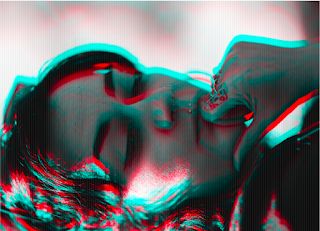Layers and overlays...

For this project it was vital to use photoshop to experiment with the opacity of the overlay before printing. Even this only helped to a small extent as the thickness of the tracing paper played a big part in the final result. Below you can see some examples of the images...both on their own and also with the overlay included. This is the original image. I initially wanted to create a glitch effect but after viewing the image with 3D glasses it appears that the blue and red edging created when making the glitch effect give the image a depth that isn't there without the glasses. This has given us ideas for a sequel to the book. This example shows the image with the overlay of a space helmet included. It was so black at 100 % opacity that it required some adjustments and test prints before finalising the whole image. This image shows how easily changes can be made to improve the opacity of the overlay. In this instance I think I lowered it too much....





